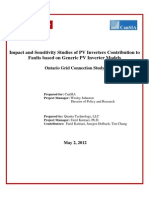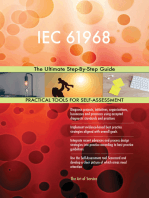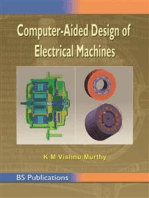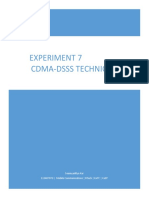Auto-Recloser Circuit Breaker in Power System Based On Internet of Things For Smart Grid
Auto-Recloser Circuit Breaker in Power System Based On Internet of Things For Smart Grid
Uploaded by
jiregnaOriginal Title
Copyright
Available Formats
Share this document
Did you find this document useful?
Is this content inappropriate?
Report this DocumentCopyright:
Available Formats
Auto-Recloser Circuit Breaker in Power System Based On Internet of Things For Smart Grid
Auto-Recloser Circuit Breaker in Power System Based On Internet of Things For Smart Grid
Uploaded by
jiregnaCopyright:
Available Formats
International Journal of Engineering, Applied and Management Sciences Paradigms (IJEAM)
Auto-Recloser Circuit Breaker in Power System
Based on Internet of Things for Smart Grid
Ali Hadi Abdulwahid1
1
Department of Elect.Power Eng.Tech., Engineering Technical College,
Southern Technical University, Basrah, Iraq
Abstract- The Internet of Things (IoT) technology has become an important issue in improving the competitiveness of
the industry, making our daily lives more comfortable. Electricity is not only a pillar of the country's economy but also a
key factor in the development of human life. Therefore, the integration of things in the field of power to solve the problem
of power interruption is one of the solutions to reliability problems. For better performance and reliable supply to
customers. The study focused on the re-closer device and developing the smart grid. Auto Re-Closing is a key element in
the concept of self-healing grids. According to statistics, many faults of the transmission and distribution network are
transient faults. In the Smart grid, an important aspect of intelligent power distribution systems is integrated with
intelligent control and protection equipment. Therefore, there is an urgent need to find a new smart self-reclosing model
to improve the protection of power distribution systems to solve and overcome the challenges of the smart grid and
distributed power generation integration.
This paper proposes a auto-reclosing protection with a controller designed for Smart Grid Integration. The model control
circuit is synchronized with the circuit breaker so that after a fault occurs, the switch automatically turns off without any
human interference. The article analyzes the impact of the integration of IoT technologies and decentralized power
generation on the reliability of power systems. According to the research results, the Internet of things can significantly
improve system reliability through fast and reliable data management. This paper introduced the application of IoT in
the online monitoring system of the power transmission line.
Keywords – Internet of things, Smart Grid, Microgrid, Distributed energy resources, Auto-reclosing protection
I. INTRODUCTION
Everyone is willing to deploy a” smart grid” to provide energy services and information technology that
significantly improves the protection, reliability, operational efficiency, power quality, safety and customer
satisfaction of distribution systems. Auto-reclosing is used to restore the original state of the network without any
human interaction [1]. Recently, electricity supply has been the main issue discussed in the media and conferences
both on the national or international level. As a result, the rapid development of the world, an electricity supply issue
is important to the whole country. However, due to a transient fault, blackouts have become one of the main
problems that often occur. This situation creates a major problem because most of the damaged equipment is caused
by an unexpected current overload [2, 3]. Because of this damage, consumers have suffered substantial losses,
particularly in the factory and industrial sectors, which then affects productivity. Therefore, Iraq's major electricity
suppliers must guarantee high-reliability power supply to their customers. Thus, each overhead line is fitted with an
auto-reclosing circuit breaker to ensure uninterrupted power supplies. In addition, the device is also suitable for
transmission lines [4,5].
This project mainly focuses on the use of low voltage power supplies with domestic users, such as residential
communities as Smart Grids. In addition, the project is also capable of over-current protection. The larger the
current, the hotter the conductor, because more heat is being generated. Therefore, there must be an overcurrent
protection device on all devices. This also reduces the risk of damage to the equipment. In addition, the protection
system is, therefore, more reliable for the user. With the development of Science and technology in the new era, the
circuit breaker has become one of the most reliable protective equipment [6-8]. Circuit breakers are mechanical
switches used in most overhead power lines to protect the line from faults that may cause damage to the power line.
It should be able to safely turn off the devices with the specified capability and safely turn them on. The circuit
breaker will automatically interrupt the abnormal current until it reaches the breaking capacity and is capable of
continuously carrying any current-up to the rated current. The abnormal condition is referred to as the overload and
short circuit. It works by measuring the current balance between the two current transformers. As long as the current
difference between the line and the neutral conductor are detected, the device opens the contact point [9,10].
The rest of this paper is arranged as follows. Section II explains the recommendations for embedded monitoring
systems based on the internet. The proposed algorithm is explained in section III. The experimental results are
presented in Section IV. The concluding observations are contained in Section V.
Volume 54 Issue 3 June 2019 234 ISSN 2320-6608
International Journal of Engineering, Applied and Management Sciences Paradigms (IJEAM)
II. TRANSMISSION LINE ONLINE MONITORING SYSTEM BASED ON INTERNET OF THINGS
Transmission line monitoring system is one of the most important applications of the Internet of things in the smart
grid, especially for disaster prevention and mitigation of transmission lines. In recent years, natural disasters have
posed many challenges to high-voltage transmission facilities, including security, stability and reliability. Moreover,
the current transmission line monitoring operation is mainly achieved by manual operation, these operations face
low efficiency, low accuracy, long operating cycle problems.
At present, some transmission line monitoring system has been put into operation. These systems typically use a
wireless public network or other wireless communication networks for data transmission to each sensor, but there
are high operating and maintenance costs, network coverage is not complete, the data transmission rate is low,
complex network maintenance, will restrict the transmission line monitoring system development, hinder the
transmission efficiency.
In order to achieve real-time online monitoring of transmission lines, the wireless sensors deployment.
Transmission line monitoring system consists of two parts. Apart is installed together with the power transmission
line to monitor the state of the conductor; another part is installed on the transmission tower to monitor the state of
the environment and the tower. Communication between IoT devices on power transmission lines and transmission
towers is typically based on short-range wireless communication technology.
The transmission line online monitoring system based on the Internet of things can transmit the information farther
through the multi-hop relay communication network, thus ensuring the effective information transmission facilities
of long span and long distance. According to the different application scenarios of transmission lines, the system
network topology can be based on the cluster chain type.
Each sensor can communicate directly with a nearby backbone node, and the communication link between the
sensor and the backbone node is generally unidirectional; each backbone node can communicate with up to 256
sensors. The communication link between the backbone nodes based bidirectional link. Some parts of the backbone
node can access the public network or power optical network. As shown in Figure 1.
Figure 1 Data transmission network
The specific monitoring contents are as follows:
(1) Transmission tower leaning
The leaning sensor will transmit the status of the transmission tower to the nearby nodes nearby, the data from
multiple tilt sensors are combined to form a transmission tower tilt information, real-time monitoring and early
warning.
(2) Conductor galloping
According to the calculation and analysis of the monitoring point acceleration, the number of vertical and horizontal
half-waves of the galloped conductor can be analyzed and the motion track can be calculated. Thus whether the
conductor is in galloping danger can be determined, and the discharge between phase conductors and tower collapse
can be avoided.
(3) wind deviation
Volume 54 Issue 3 June 2019 235 ISSN 2320-6608
International Journal of Engineering, Applied and Management Sciences Paradigms (IJEAM)
Wind deflection can be calculated by deploying a three-dimensional acceleration sensor on the conductor. Wind
deviation data from the wind speed sensor, an acceleration sensor may be provided for the winding conductor
deviation verification field test data. The operator can take reasonable measures to resist wind bias.
(4) micro-Meteorology
Temperature, humidity, wind speed, sunshine and rainfall can be recorded by wireless sensors along the conductor
or tower. Based on the results of micro-meteorological sensors and tension sensors. The data analysis system at the
monitoring centre analyzes the information collected by the sensors and makes early warning decisions.
Figure 2 Sensor deployment for transmission lines and transmission towers
(5) conductor temperature
The operating temperature of the conductor can be collected along the conductor by a wireless temperature sensor.
Transmission lines and Tower sensor deployment scheme is shown in Figure 2.Equipment including temperature,
humidity, wind and other meteorological sensors, vibration sensors, ultrasonic sensors, Tower sensors, infrared
sensors, leakage current sensors, cameras and backbone nodes, to build transmission lines and tower monitoring
system. Wireless sensor image and its deployment as shown in Figures 3.
Figure 3 Wireless sensors
Backbone nodes deployed within the transmission tower to collect data near the wireless sensor, the combined
information is transmitted to the Monitoring Center via a mobile communication network or a private network of
electricity, to achieve long-distance, flexible, convenient, high-speed transmission of information. Reliable, high-
quality interconnection between the transmission facilities and the monitoring centre.Transmission line on-line
monitoring system through the information management system to achieve real-time monitoring, information
display, statistical analysis. The status of the power transmission facility can be visually displayed. Operators can
make decisions and give orders based on the results of the analysis of the information management system, in order
to identify or eliminate risks as early as possible, to ensure reliable operation of the transmission facilities[11-13].
III. PROPOSED SOLUTION
Recloser is a circuit breaker as well as overhead power line protection system designed to reconnect to the fault. It
detects the fault and turns on the pre-programmed time before it turns off automatically. The cycle can be repeated 4
times. And usually locked in the fifth trip, as shown in Figure 4. Reclosing can be used anywhere on the system
where the recloser rating is sufficient for the logical location of the system requirements[14-16]:
* In the substation as the main feeder protection device.
Volume 54 Issue 3 June 2019 236 ISSN 2320-6608
International Journal of Engineering, Applied and Management Sciences Paradigms (IJEAM)
* On the line at a distance from the substation, the long feeder segment, thereby preventing the feeder in the vicinity
of the end of permanent failure of the entire feeder down.
* On the tap of the main feeder to protect the main feeder from interruptions and power outages caused by tap
failure.[7]
Figure 4 Power recloser with disconnect links schematic diagram.
This paper illustrates a new protection scheme for smart microgrids systems and their simulation performance using
digital relays in Matlab / Simulink. The proposed AR control circuit is responsible for tripping and closing the
circuit breaker in different fault situations to isolate or restore energy services[17-19].
3.1 Auto-Recloser Protection Scheme
The Hall Effect current sensor adopts the following principle of electromagnetic isolation, which are small size,
lightweight, low price, fast response, high precision, good stability, non-invasive entry, the whole diameter of
35mm-55mm and installation in DIN rail. The Hall effect AC current sensor is widely used for measuring current in
several fields [11].
Figure 5 Power recloser with disconnect links schematic diagram.
The ATmega328 is an 8-bit Complementary Metal–Oxide–Semiconductor (CMOS) microcontroller based on the
AVR-improved RISC architecture. By allowing only powerful commands in the clock cycle, the Atmega328 also
gains product access to 1 MIPS per 1MHz, Arduino one is a microcontroller board based on ATmega328. There are
14 digital I/O pins (6 of which can be used as PWM outputs), 6 analog inputs, a 16 MHz crystal oscillator, using the
analog voltage comparator, the inputs can be tested with 2 analog A0, A1 inputs, and digital outputs [20-21]. Below
is the code for the proposed program.
Volume 54 Issue 3 June 2019 237 ISSN 2320-6608
International Journal of Engineering, Applied and Management Sciences Paradigms (IJEAM)
Note that the arduino inputs can detect analog voltages from 0 to 5v to the ground, the sampling rate is
approximately 67 microseconds between each analog reading, the discrimination resolution is approximately 5 milli-
Volts.
IV. SIMULATION AND RESULTS
The current sensor detects over current in case of overloading. After the sensor detects the current flow of a larger
load, the programmed pre-set, the microcontroller will activate the relay to cut off the power from the main
electricity provider to the load. For simulation, MATLAB software was used. In this software, the simulation is
performed by ensuring that the transmission line has a load. The circuit breaker is used to open loads during the fault
moment and is re-closed when the fault has been cleared. The Simulink model is shown in Figure 3. In this model,
when the signal is given to the switch, there will be a fault within the system, and the immediate circuit breaker
operation will begin and disconnects from the system and the faulty components. Different voltage imbalances have
been observed, such as (Line to Line), LG (Line to Ground), 3L(Three Lines). These failures are performed by
shutting down the faulty switch in the Simulink model. These faults are both temporary and permanent. The x-axis
displays the time, and the y-axis shows the three system voltages, currents, and fault currents between the two
contacts of the circuit breaker. As it can be seen in Figure 5, the fault occurs in a line within 0.5 seconds and is
cleared within 0.7 seconds. This is a temporary failure, which is cleared by an automatic reset.
4.1 Case One-
In the case of a temporary fault, the system's faulty zone must be isolated automatically to protect the network from
adverse consequences. Due to the high current level caused by a permanent fault, overcurrent protection with the
auto-recloser system will resume, so the trip signal will take the time delay setting, and then the circuit breaker
opens its contacts to eliminate the error. Figure 5 shows the proposed performance of the auto-recloser system in the
case of a constant single phase to ground, which is also common in the grid.
Figure 6 Temporary Single line to ground fault
4.2 Case Two-
The case of a temporary double fault is that the object causing the fault requires extra time. The AR will close the
successful connection, and restore the system in safe mode, and there is no extra outage time that will additionally
affect the reliability and quality of the distribution system. Figure 6 shows the performance of the system in the case
Volume 54 Issue 3 June 2019 238 ISSN 2320-6608
International Journal of Engineering, Applied and Management Sciences Paradigms (IJEAM)
of a two-phase fault of the system. In addition, the performance of the proposed system appears in the case of a
temporary fault.
Figure 7 Temporary Double phase to ground fault
V.CONCLUSION
The Internet of things is considered the third revolution in digital technology after computers and the internet. At
present, the power grid is transforming to the smart grid, and the requirements of automation and intelligence will
lead to the deep integration of the Internet of things and the smart grid.
Through the technology of IoT, the operating parameters of the power transmission line and the tower can be
achieved. Therefore, Disaster Monitoring and early warning can be carried out, which will effectively resist or
reduce the damage of major natural disasters to the power grid.
Utility companies are implementing advanced smart grids, computerized distribution networks to increase efficiency
and minimize disruption to consumers during temporary faults. By using the modern control distribution automation
for remote reconnection, utility companies are able to implement intelligent protection floor to isolate short sections
of the feeder that are defective and divert energy to ensure that, as many consumers remain connected to the network
in case of failure.
The main functions of the power system are continuity and reliability, it is the correct operation of the system; all its
components work normally. The recent technological advances have improved the reliability of the network. The
purpose of the AR function is to restore the continuity of the feeding system as soon as possible. The auto-close
function works after each breakdown and automatically closes the line that has been disabled due to the trigger
signal sent from the protection system when a fault occurs usually, this function turns off the line for several cycles
after the Circuit Breaker (CB) is turned on. When the system detects a temporary or unsuccessful error, it must then
notify the automatic auto-reclose cycle in order to be ready. Only the damaged line is isolated. Then the other lines
continue to supply energy to the energy system. To provide energy for consumers the start time can be adjusted.
One of the most important reasons for using a bus scheme is reliability.
In this paper, a new auto-recloser device is proposed with directional overcurrent protection, which adds new
features to the protection system. As a preparation for the integration of Distributed Generation (DG), new
challenges are placed on traditional protection systems. The system was simulated, the performance of the auto-
reclosing was verified, and the auto-recloser device will successfully eliminate the transient and semi-permanent
faults on the distribution line. There are two kinds of faults that are common to the distribution system which are
simulated.
VI. ACKNOWLEDGMENT
I would like to express my gratitude to Prof. Shaorong Wang for the useful comments. In addition, I would like to
thank Mrs. Janan Al-hajji for the support. I would like to thank the reviewers’ participants in conferences.
Volume 54 Issue 3 June 2019 239 ISSN 2320-6608
International Journal of Engineering, Applied and Management Sciences Paradigms (IJEAM)
VII. REFERENCES
[1] H. Abdulwahid, S. Wang "A Novel Method of Protection to Prevent Reverse Power Flow Based on Neuro-Fuzzy Networks for Smart Grid"
Sustainability, April 2018 10(4); DOI: 10.3390/su10041059
[2] Liang Wang, Qirong Jiang, Lucheng Hong, Chunpeng Zhang, Yingdong Wei, "A Novel Phase-Locked Loop Based on Frequency Detector
and Initial Phase Angle Detector", IEEE Transaction on Power Electronics, vol. 28, no. 10, pp. 4538-4549, Outubro 2013.
[3] Zhang, X., Xu, Z., Gao, B., et al.: "Compensation scheme for secondary arc current on four circuit parallel transmission lines", IET Gener.
Transm. Distrib., 10, (9), pp. 2079–2086, 2016.
[4] Gajare, S., Pradhan, A.K.: "Synchrophasor based intelligent autoreclosing scheme for series compensated transmission lines", IEEE Trans.
Power Deliv., 32, (5), pp. 2255–2262,2017.
[5] A.H. Abdulwahid and S. Wang, "Application of Differential Protection Technique of Domestic Solar Photovoltaic Based Microgrid,
"International Journal of Control and Automation, vol. 9, pp. 371-386, 2016.
[6] Nagpal, M., Manuel, S.H., Bell, B.E., et al.: ‘Field verification of secondary arc extinction logic’, IEEE Trans. Power Deliv., 2016, 31, (4),
pp. 1864–1872 [5] Vogelsang, J., Romeis, C., Jaeger, J.: ‘Real-time adaption of dead time for single-phase autoreclosing’, IEEE Trans.
Power Deliv., 31, (4), pp.1882–1890, 2016
[7] Sima, W., Wang, R., Yang, M., et al.: "Secondary arc current of ultra-high voltage transmission line with a mixed voltage of 1000/500 kV
on a single tower", IET Gener. Transm. Distrib., 9, (7), pp. 686–693, 2015
[8] Dias, O.F., Tavares, M.C.: "Comparison between traditional single-phase auto reclosing and adaptive technique based on harmonic content
measurement", IET Gener. Transm. Distrib., 11, (4), pp. 905–914, 2017
[9] Dias, O.F., Tavares, M.C.: "Implementation and performance evaluation of a harmonic filter for use in adaptive single-phase reclosing",
IET Gener. Transm. Distrib., 11, (9), pp. 2261–2268, 2017
[10] A. H. Abdulwahidand S. Wang, "A busbar differential protection based on fuzzy reasoning system and Rogowski-coil current sensor for
microgrid," IEEE PES Asia-Pacific Power and Energy Engineering Conference (APPEEC), 2016, pp. 194-199. DOI:
10.1109/APPEEC.2016.7779496
[11] A.H.Abdulwahid; S. Wang "A new protection approach for microgrid based upon combined ANFIS with Symmetrical Components "IEEE
PES Asia-Pacific Power and Energy Engineering Conference (APPEEC), 2016, DOI: 10.1109/APPEEC.2016.7779851
[12] Jalilzadeh Hamidi R, Livani H. "Traveling wave-based fault location algorithm for hybrid multi-terminal circuits". IEEE Trans Power
Deliver;32(1):135–44, Feb. 2017.
[13] Sathish Bakanagari,(2013) "Three Phase Fault Analysis with Auto Reset for Temporary Fault and Trip for Permanent Fault" Int. Journal of
Engineering Research and Applications vol.3,1082-1086
[14] Sathish Bakanagari, A. Mahesh Kumar, M. Cheenya, "Three Phase Fault Analysis with Auto Reset for Temporary Fault and Trip for
Permanent Fault” IJRET ISSN : 2248-9622, vol. 3, Issue 6, pp.10821086, Dec 2013 .
[15] H. Khorashadi, Zadeh, Z. Li, "Design of a novel Phasor Measurement Unit-based Transmission line Auto-Reclosing Scheme", IET
Generation Transmission and Distribution, vol. 5, no. 8, pp. 806-813, 2011.
[16] Xinyan Wang ; Jing Li "Design of Intelligent Home Security Monitoring System Based on Android " 2nd IEEE Advanced Information
Management,Communicates,Electronic and Automation Control Conference (IMCEC), pp. 2621 - 2624, 2018
[17] Milioudis AN, Andreou GT, Labridis DP. "Detection and location of high impedance faults in multiconductor overhead distribution lines
using power line communication devices ". IEEE Trans Smart Grid,6(2):894–902,2015.
[18] Apostolos N. Milioudis ; Georgios T. Andreou ; Dimitrios P. Labridis "Enhanced Protection Scheme for Smart Grids Using Power Line
Communications Techniques—Part II: Location of High Impedance Fault Position" IEEE Transactions on Smart Grid , vol. 3, no. 4, pp.
1631 - 1640, 2012.
[19] P. Amirshahi, M. Kavehrad, "Medium voltage overhead power-line broadband communications; Transmission capacity and electromagnetic
interference", Proc. Int. Symp. Power Line Commun. Its Appl., pp. 2-6, 2005.
[20] J. Anatory, N. Theethayi, R. Thottappillil, M. Kissaka, N. Mvungi, "Broadband power-line communications: The channel capacity
analysis", IEEE Trans. Power Del., vol. 23, no. 1, pp. 164-170, Jan. 2008.
[21] A. H. Abdulwahid and S. Wang, "A Novel Approach for Microgrid Protection Based upon Combined ANFIS and Hilbert Space-Based
Power Setting,” Energies, vol. 9, p. 1042, 2016
Volume 54 Issue 3 June 2019 240 ISSN 2320-6608
You might also like
- CP102 FinalDocument2 pagesCP102 Finaljordancao01100% (1)
- Design and Implementation of AMR System Using Arduino and Digital Energy MeterDocument4 pagesDesign and Implementation of AMR System Using Arduino and Digital Energy MeterEngidNo ratings yet
- Embedded IoT Assignment Answers TemplateDocument5 pagesEmbedded IoT Assignment Answers TemplateMuhannad TahaNo ratings yet
- 07-Fabrication of Mini Hydraulic Pipe ViceDocument3 pages07-Fabrication of Mini Hydraulic Pipe ViceVignesan Mech100% (2)
- Intelligent Lighting System For Railway PlatformsDocument3 pagesIntelligent Lighting System For Railway PlatformsMahesh MahiNo ratings yet
- Automatic Paper Cutting Using Geneva MechanismDocument4 pagesAutomatic Paper Cutting Using Geneva MechanismsankaramarayananNo ratings yet
- Project - File of Electricity Biling SystemDocument10 pagesProject - File of Electricity Biling SystemNiraj GuptaNo ratings yet
- Project SCADA Kel 1Document28 pagesProject SCADA Kel 1Muhammad KhairuddinNo ratings yet
- Dispatch and Scheduling Processes - December 09Document10 pagesDispatch and Scheduling Processes - December 09msalmanishaqNo ratings yet
- Chapter One: Introduction 1.1 Background of The StudyDocument30 pagesChapter One: Introduction 1.1 Background of The StudyUzoma FrancisNo ratings yet
- Smart Energy Meter Using Arduino and GSM Sim900aDocument6 pagesSmart Energy Meter Using Arduino and GSM Sim900aRoman PuriNo ratings yet
- Flywheel Energy Storage System: Bachelor of TechnologyDocument13 pagesFlywheel Energy Storage System: Bachelor of Technologymadhu kotlaNo ratings yet
- Underground Cable Fault Detection Using ZigbeeDocument36 pagesUnderground Cable Fault Detection Using ZigbeeRana AbrarNo ratings yet
- Prepaid Energy MeterDocument131 pagesPrepaid Energy Metersatyajit_manna_2100% (1)
- Smart Home Energy Management SystemDocument4 pagesSmart Home Energy Management SystemDikimbie GatpuNo ratings yet
- Foot Step Power Generating SystemDocument16 pagesFoot Step Power Generating SystemAjeesh Rajan100% (2)
- File-STREET LIGHT THAT GLOWS ON DETECTING VEHICLE MOVEMENTDocument2 pagesFile-STREET LIGHT THAT GLOWS ON DETECTING VEHICLE MOVEMENTChhaya Rathi0% (1)
- Electric ReportDocument33 pagesElectric ReportAkshay bypNo ratings yet
- IOT Based Smart Energy Meter With Auto Daily Tariff Calculations Over Internet.Document3 pagesIOT Based Smart Energy Meter With Auto Daily Tariff Calculations Over Internet.dileeppatraNo ratings yet
- Vijay Halilole.: Fabrication of Vertical Axis Wind TurbineDocument45 pagesVijay Halilole.: Fabrication of Vertical Axis Wind TurbineThaha Refaye0% (2)
- Iot Based Solar Monitoring and Tracking SystemDocument12 pagesIot Based Solar Monitoring and Tracking SystemGowri ManognaNo ratings yet
- Simulation and Implementation of PLC Based For Detecting Burned Potato Chips and Remove Using PLCSIM and HMIDocument6 pagesSimulation and Implementation of PLC Based For Detecting Burned Potato Chips and Remove Using PLCSIM and HMIEditor IJTSRDNo ratings yet
- 03.PIR and GSM Based House Security SystemDocument4 pages03.PIR and GSM Based House Security SystemkranthirishiNo ratings yet
- Speed Control of DC Motor Using PWMDocument8 pagesSpeed Control of DC Motor Using PWMsunny kumarNo ratings yet
- Power System ContingenciesDocument31 pagesPower System ContingenciesSal ExcelNo ratings yet
- Training Report NHPCDocument43 pagesTraining Report NHPCVikas SandhuNo ratings yet
- Remote Data Acquisition Using WirelessDocument3 pagesRemote Data Acquisition Using WirelessGoutham RajNo ratings yet
- Hstory of Fault Contribution Solar InverterDocument143 pagesHstory of Fault Contribution Solar InverterLisa MarshNo ratings yet
- Final Report Format2Document58 pagesFinal Report Format2aswathy_menon_4No ratings yet
- Transmission Line Fault MonitoringDocument16 pagesTransmission Line Fault MonitoringVikash Vicky KumarNo ratings yet
- SMPS PresentationDocument33 pagesSMPS PresentationGeorge AntonyNo ratings yet
- IoT BASED ELECTRIC ENERGY METERDocument3 pagesIoT BASED ELECTRIC ENERGY METERFa EsalNo ratings yet
- Smart Energy Meter - Project Report BEDocument55 pagesSmart Energy Meter - Project Report BEvishalmate10No ratings yet
- Passport Automation System - FDocument16 pagesPassport Automation System - FSivâranjiniNo ratings yet
- Taxonomy of Parallel Computing ParadigmsDocument9 pagesTaxonomy of Parallel Computing ParadigmssushmaNo ratings yet
- JUTA CM5024Z Solar Charge ControllerDocument11 pagesJUTA CM5024Z Solar Charge ControllerJorge CarrascoNo ratings yet
- Smart Home With Google Assistant & Alexa Using NodeMCU ESP8266 - IotCircuitHubDocument19 pagesSmart Home With Google Assistant & Alexa Using NodeMCU ESP8266 - IotCircuitHubrudrathehacker9164No ratings yet
- Solar Powered Rover and Obstacle DetectorDocument22 pagesSolar Powered Rover and Obstacle DetectorAnjna SinhaNo ratings yet
- Lecture Notes Unit 2 Smart Grid1Document25 pagesLecture Notes Unit 2 Smart Grid1Saurabh BhardwajNo ratings yet
- Iot Solar Power Monitoring SystemDocument6 pagesIot Solar Power Monitoring SystemSSReddy100% (1)
- Training Report ElectricalDocument22 pagesTraining Report ElectricalMuhd Shahir SallehNo ratings yet
- Micro Controller Based Digital Clock With CalendarDocument8 pagesMicro Controller Based Digital Clock With CalendarPratyay Dhar33% (3)
- Solar Charge ControllerDocument11 pagesSolar Charge Controllerayirp89No ratings yet
- Motor Speed Control System by Using GSM MobileDocument16 pagesMotor Speed Control System by Using GSM MobileAditya TomarNo ratings yet
- Design and Implementation of A Solar Integration IDocument7 pagesDesign and Implementation of A Solar Integration IAmir KalčoNo ratings yet
- Project Title: A Presentation OnDocument23 pagesProject Title: A Presentation OnAnonymous qh5UUGTNo ratings yet
- GSM Based Motor Control: A Mini Project Report OnDocument94 pagesGSM Based Motor Control: A Mini Project Report Onsra1 reddyNo ratings yet
- SRS of College Event Management SystemDocument5 pagesSRS of College Event Management SystemRachel GrayNo ratings yet
- Asynchronous ChipsDocument25 pagesAsynchronous ChipsAbin Varkey Varghese100% (1)
- Modern Courier Collection Box With Iot Security Using Rfid Technology.Document67 pagesModern Courier Collection Box With Iot Security Using Rfid Technology.RAJASHEKHARNo ratings yet
- 85.intelligent Fire Detector With Automatic Water Sprinkler System To Avoid Fire AccidentsDocument3 pages85.intelligent Fire Detector With Automatic Water Sprinkler System To Avoid Fire AccidentsvenkeyharishNo ratings yet
- 19 IoT Based Smart Parking and Traffic Management System For Modern CitiesDocument2 pages19 IoT Based Smart Parking and Traffic Management System For Modern CitiesdileeppatraNo ratings yet
- Iot Based Smart Energy Meter Monitoring, Theft Detection and DisconnectionDocument6 pagesIot Based Smart Energy Meter Monitoring, Theft Detection and DisconnectionNkK SarMa100% (1)
- GSM Based Transformer Fault Monitoring SystemDocument5 pagesGSM Based Transformer Fault Monitoring SystemEditor IJTSRDNo ratings yet
- Chapter - 1 1.1 OverviewDocument21 pagesChapter - 1 1.1 OverviewTirumalarao PechettyNo ratings yet
- SeminarDocument23 pagesSeminaraartitomar47_8332176No ratings yet
- User Manual 2720831Document2 pagesUser Manual 2720831Temitope SoneyeNo ratings yet
- 4G GPS Tracker Price ListDocument3 pages4G GPS Tracker Price Listrongli leeNo ratings yet
- GMDSS: Global Maritime Distress and Safety SystemDocument110 pagesGMDSS: Global Maritime Distress and Safety SystemAmin Al Qawasmeh100% (1)
- Instruction Manual: MF/HF Marine TransceiverDocument100 pagesInstruction Manual: MF/HF Marine TransceiverAndrej1000No ratings yet
- Codan C-Band 6700 BUCDocument3 pagesCodan C-Band 6700 BUCgiscard85No ratings yet
- Provider-netID 06 2011Document73 pagesProvider-netID 06 2011Tin Velasco0% (1)
- Adaptive Cruise Control Acc Full ReportDocument22 pagesAdaptive Cruise Control Acc Full ReportdadasariNo ratings yet
- UL Interference Analysis ProcedureDocument10 pagesUL Interference Analysis ProcedureKuda BetinaNo ratings yet
- SDCCH Drop RateDocument4 pagesSDCCH Drop RateZeeNo ratings yet
- Acom McqsDocument14 pagesAcom McqsIshmaal KhanNo ratings yet
- Ourlog 8091Document2 pagesOurlog 8091Alucard FFNo ratings yet
- Longshine WA5 40P Manual EngDocument50 pagesLongshine WA5 40P Manual EngqueerprodigyNo ratings yet
- Ceescope Brochure 2015Document2 pagesCeescope Brochure 2015Gustavo Luiz GiorgianoNo ratings yet
- Basic SatelliteDocument65 pagesBasic Satellitemunini100% (1)
- Introduction To 3G/UMTS PerformanceDocument12 pagesIntroduction To 3G/UMTS PerformanceKiko EsguerraNo ratings yet
- Radio Tesla PDFDocument38 pagesRadio Tesla PDFTrie Nou100% (1)
- Experiment 7 DSSS Technique For CDMADocument7 pagesExperiment 7 DSSS Technique For CDMAHoney KumarNo ratings yet
- Basic Monostable Radar MatlabDocument8 pagesBasic Monostable Radar MatlabGautham KannanNo ratings yet
- 1 44 48 en 104 PDFDocument533 pages1 44 48 en 104 PDFSang Phan ThanhNo ratings yet
- Next Generation Multiple Access IEEE Press Wiley, 2024 @persianDocument604 pagesNext Generation Multiple Access IEEE Press Wiley, 2024 @persianMarlon IngarucaNo ratings yet
- 04 Mobility Management in NSN SGSN SG7 CN3122EN70GLN00Document53 pages04 Mobility Management in NSN SGSN SG7 CN3122EN70GLN00Raven ZavenNo ratings yet
- All India Radio (Jaipur) : A Practical Training Presentation ONDocument28 pagesAll India Radio (Jaipur) : A Practical Training Presentation ONSiddharth NagayachNo ratings yet
- Alcatel-Lucent 9412 eNodeB CompactDocument2 pagesAlcatel-Lucent 9412 eNodeB Compactomauriciogal100% (2)
- FAQ Auto Correlation Matlab Code - Cross Correlation Matlab CodeDocument5 pagesFAQ Auto Correlation Matlab Code - Cross Correlation Matlab Codeanon_374567901No ratings yet
- New Vector 4000Document2 pagesNew Vector 4000Marcos MillerNo ratings yet
- Stream: 6-Port AntennaDocument6 pagesStream: 6-Port AntennaThomas NoelNo ratings yet
- Datasheet Q48 Point To Point (PD8630)Document2 pagesDatasheet Q48 Point To Point (PD8630)Ricky YoungNo ratings yet
- Design and Simulation of Pulse Code Modulation Multiplexing (PCMM) and De-Multiplexing Technique in MATLABDocument4 pagesDesign and Simulation of Pulse Code Modulation Multiplexing (PCMM) and De-Multiplexing Technique in MATLABAyesha RasheedNo ratings yet
- GNSS Processing Report Kebun SawitDocument7 pagesGNSS Processing Report Kebun SawitRidwanNo ratings yet

























































































